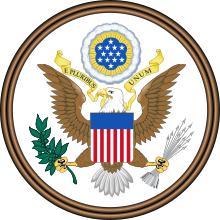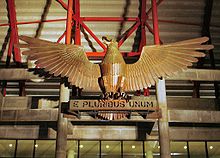From Wikipedia, the free encyclopedia [footnote references can be found in original article]
E pluribus unum (/ˈiː ˈplʊərᵻbəs ˈuːnəm/; Latin: [ˈeː ˈpluːrɪbʊs ˈuːnʊ̃])—Latin for "Out of many, one"[1][2] (alternatively translated as "One out of many"[3]or "One from many")[4] — is a 13-letter phrase on the Seal of the United States, along with Annuit cœptis (Latin for "He approves (has approved) of the undertakings") and Novus ordo seclorum (Latin for "New Order of the Ages"), and adopted by an Act of Congress in 1782.[2][5] Never codified by law, E Pluribus Unum was considered a de facto motto of the United States[6]until 1956 when the United States Congress passed an act (H. J. Resolution 396), adopting "In God We Trust" as the official motto.[7]
Contents
[hide]Origins[edit]
The 13-letter motto was suggested in 1776 by Pierre Eugene du Simitiere to the committee responsible for developing the seal. At the time of the American Revolution, the exact phrase appeared prominently on the title page of every issue of a popular periodical, The Gentleman's Magazine,[8][9] which collected articles from many sources into one "magazine". This in turn can be traced back to the London-based Huguenot Peter Anthony Motteux, who used the adage for his The Gentleman's Journal, or the Monthly Miscellany (1692-1694). The phrase is similar to a Latin translation of a variation of Heraclitus's 10th fragment, "The one is made up of all things, and all things issue from the one." A variant of the phrase was used in Moretum, a poem attributed to Virgil but with the actual author unknown, describing (on the surface at least) the making of moretum, a kind of herb and cheese spread related to modern pesto. In the poem text, color est e pluribus unus describes the blending of colors into one. St Augustine used the non-truncated variant of the phrase, ex pluribus unum, in his Confessions (e is an abbreviation for the common Latin preposition ex). But it seems more likely that the phrase refers to Cicero's paraphrase of Pythagoras in his De Officiis, as part of his discussion of basic family and social bonds as the origin of societies and states: "When each person loves the other as much as himself, it makes one out of many (unus fiat ex pluribus), as Pythagoras wishes things to be in friendship."[10]
While Annuit cœptis and Novus ordo seclorum appear on the reverse side of the great seal, E pluribus unum appears on the obverse side of the seal (Designed by Charles Thomson), the image of which is used as the national emblem of the United States, and appears on official documents such as passports. It also appears on the seal of the President and in the seals of the Vice President of the United States, of the United States Congress, of the United States House of Representatives, of the United States Senate and on the seal of the United States Supreme Court. It is on the five dollar bill.
Meaning[edit]
The traditionally understood meaning of the phrase was that out of many states (or colonies) emerges a single nation. However, in recent years its meaning has come to suggest that out of many peoples, races, religions, languages, and ancestries has emerged a single people and nation—illustrating the concept of the melting pot.[11]
Usage on coins[edit]
The first coins with E pluribus unum were dated 1786 and struck under the authorization of the State of New Jersey by Thomas Goadsby and Albion Cox in Rahway, New Jersey.[12] The motto had no New Jersey linkage but was likely an available die that had been created by Walter Mould the previous year for a failed federal coinage proposal.[13] Walter Mould was also authorized by New Jersey to strike state coppers with this motto and did so beginning in early 1787 in Morristown, New Jersey. Lt. Col. Seth Read ofUxbridge, Massachusetts was said to have been instrumental in having E Pluribus Unum placed on US coins[14] Seth Read and his brother Joseph Read had been authorized by the Massachusetts General Court to mint coppers in 1786. In March 1786, Seth Read petitioned the Massachusetts General Court, both the House and the Senate, for a franchise to mint coins, both copper and silver, and "it was concurred".[15][16] E pluribus unum, written in capital letters, is included on most U.S. currency, with some exceptions to the letter spacing (such as the reverse of the dime). It is also embossed on the edge of the dollar coin. (See United States coinage and paper bills in circulation).
According to the U.S. Treasury, the motto E pluribus unum was first used on U.S. coinage in 1795, when the reverse of the half-eagle ($5 gold) coin presented the main features of the Great Seal of the United States. E pluribus unum is inscribed on the Great Seal's scroll. The motto was added to certain silver coins in 1798, and soon appeared on all of the coins made out of precious metals (gold and silver). In 1834, it was dropped from most of the gold coins to mark the change in the standard fineness of the coins. In 1837, it was dropped from the silver coins, marking the era of the Revised Mint Code. An Act of February 12, 1873 made the inscription a requirement of law upon the coins of the United States. E pluribus unum appears on all coins currently being manufactured, including the Presidential dollars that started being produced in 2007, where it is inscribed on the edge along with "In God We Trust" and the year and mint mark. After the Revolution, Rahway, New Jerseybecame the home of the first national mint to create a coin bearing the inscription E pluribus unum.
In a quality control error in early 2007 the Philadelphia Mint issued some one-dollar coins without E pluribus unum on the rim; these coins have already become collectibles.
The 2009, 2010 and the new 2011 penny features a new design on the back, which displays the phrase "E Pluribus unum" in larger letters than in previous years. It is also seen on the 2011 quarter dollar coin.[1]
Other usages[edit]
- The motto E pluribus unum is used by Portuguese multi-sport club enfica.
- This motto has also been used by the Scoutspataljon, a professional infantry battalion of the Estonian Defence Forces, since 1918.
- A variant of the motto, unum e pluribus is used by the Borough of Wokingham in Berkshire, United Kingdom.[17]
- E Pluribus Unum is a march by the composer Fred Jewell, written in 1917 during World War I.
- In 2001, following the September 11 attacks, the Ad Council and Texasad agency GSD&M launched a famous public service announcement in which ethnically diverse people say "I am an American"; near the end of the PSA, a black screen shows and the phrase "E pluribus unum" is seen with the English translation underneath.[18]
- In the film The Wizard of Oz, the wizard gives the Scarecrow a diploma from the society of E Pluribus Unum.
- In the Twilight Zone episode "A Kind of a Stopwatch", a man receives a stopwatch that can stop time and is told, "remember, e pluribus unum" as he is given the watch.
- A short story collection by Theodore Sturgeon is called "E Pluribus Unicorn".
- American author David Foster Wallace reversed the motto in his 1993 essay "E Unibus Pluram: Television and U.S. Fiction".
- "One Out of Many", a story about an Indian servant who travels to Washington with his employer, is included in V.S. Naipaul's novel In a Free State.
- The Marvel Comics character Foolkiller has calling cards that read "Foolkiller-e pluribus unum-Actions have Consequences."
See also[edit]
| Wikimedia Commons has media related to E pluribus unum. |



No comments:
Post a Comment